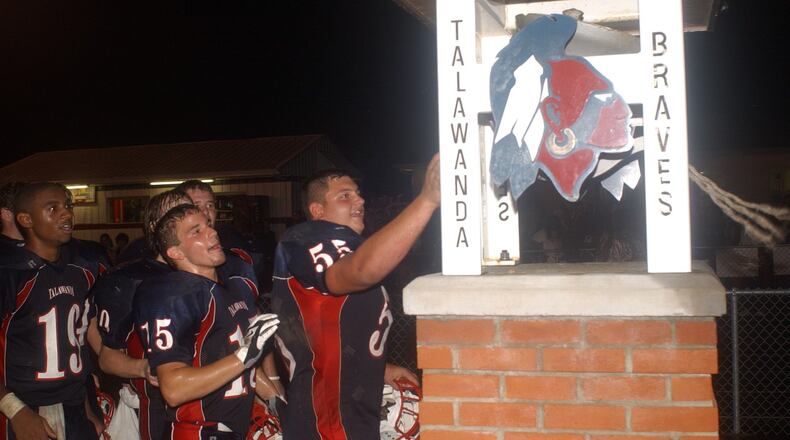Kathy McMahon-Klosterman, an Oxford resident and Miami University professor, read excerpts of the six-page letter at the school board’s June 18 meeting and urged board members to change the mascot, something that has been discussed in the past.
FROM 2010: Braves name and warrior head mascot stay, school board says
In 2010, the district’s mascot was the subject of much debate after two groups — Oxford Citizens for Peace and Justice and the Oxford branch of the National Association for the Advancement of Colored People — formed a coalition to change the mascot, a red Native American silhouette with feathers and a hoop earring, citing concerns of racial insensitivity. A third group collected more than 700 signatures on a petition to keep the Braves name and the “warrior head” mascot.
In the end, the board of education decided the Braves name and the mascot would remain.
Then in 2012, the school board chose a new logo with the Native American head as a blue silhouette.
Native American athletic mascots have been a subject of controversy since at least 1968, when the National Congress for American Indians began campaigning for their removal from professional sports.
Since then, many other high schools and colleges have replaced their Native American mascots with equivalents not based on real-life groups. The Miami University Redskins became RedHawks in 1996; the Stanford Indians became the Stanford Cardinal in 1981.
In Talawanda Schools, the Native American logo appears in district communications, such as the athletic department’s Twitter account, and on a tower holding the high school’s victory bell at the football stadium.
“The Braves logo and mascot is exclusively used by the athletics program while the red ‘T’ image is already used by academic groups and other functions,” said Holli Morrish, director of communications and public relations for the school district.
There is no current plan to evaluate the mascot, according to Morrish, but she said she expects there to be a formal request soon for a new committee to evaluate the use of the logo.
“We want to hear what our constituents, fans, students and taxpayers think,” said Morrish.
The letter from the NARF said it was prompted by contact from the Oxford Citizens for Peace and Justice. It said mascots and mascot imagery have negative psychological and educational impacts as well as “real documented harm to the mental health of Native American and Alaska Native students.”
According to the NARF, an example of this happened in recent years with a Talwanda student.
Sara Smith, who identifies as being from the Aztek Empire, is a graduate of Talawanda’s Class of 2012.
Smith said she was bullied in school because of her Native American heritage.
“As a result of her expressing her Native American identity to her classmates, her classmates responded not with honor or respect but with racial slurs and bullying that would continue until she graduated from Talawanda High School,” the NARF letter said.
It went on to say Smith wrote a letter to the board of education in 2016 telling of the bullying, racial slurs and other unacceptable behavior she had experienced, but the board refused to change the “Indian Head” imagery, according to the NARF letter.
Smith said she quit the school’s basketball team because of the mascot.
“I did not want to wear a race-based symbol that perpetuates a stereotype of me,” she said, according to the NARF.
Students who have “little contact with Indigenous people come to rely on these stereotypes to inform their own understanding of Native Americans’ place in society, often times leading to discriminatory behavior,” the NARF said.
Such practices, the group claims, also lead to higher rates of hate crimes against Native Americans.
The letter from NARF also noted the expense involved with changing a school mascot is not a reason to keep it.
Adidas provides financial help for schools across the country voluntarily choosing to change their logo and mascot away from Native American imagery through it Change the Mascot Initiative.
“Adidas’ Change the Mascot Initiative will not only financially assist the Talawanda Schools, but will also offer its design resources to the high schools and the district to change the logo and the mascot imagery,” the NARF letter said.
In Cincinnati’s Forest Hills School District, a committee recently decided it would not recommend any changes to the Redskins mascot and team name for Anderson High School.
One of the considerations that swayed some committee members toward retaining the mascot was money. Replacing all of the school’s Redskins-branded decor, athletic equipment and merchandise could cost hundreds of thousands of dollars.
“I think the numbers say don’t change,” committee member Andy Wolf said. “I think the price tag says don’t change.”
Some felt that other considerations should outweigh financial ones. Committee member Jim Frooman said a mascot based on an ethnic group “is a bad look for Forest Hills.”
Many of those supporting the mascot were Anderson High alumni who believed changing it would damage school spirit and sever a link between current and former students.
The committee’s findings, although they attracted months of engagement from opponents of the mascot as well as the “Save Our Skins” contingent, are not final. Only the Forest Hills Local School Board can decide what next steps will be taken.
“I don’t see the issue going away,” Forest Hills Schools parent Michelle Walton, who opposes the mascot, said. “So, as far as long-term situation here, I feel like we just delayed the inevitable.”
